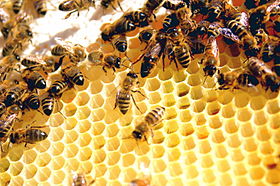
Back نحلة شغالة Arabic Пчела работничка Bulgarian Abella obrera Catalan Arbeiterin (Bienen) German Laborabelo Esperanto Abeja obrera Spanish Töömesilane Estonian Erle langile Basque زنبور کارگر Persian Abella obreira Galician

A worker bee is any female bee that lacks the reproductive capacity of the colony's queen bee and carries out the majority of tasks needed for the functioning of the hive. While worker bees are present in all eusocial bee species, the term is rarely used (outside of scientific literature) for bees other than honey bees, particularly the European honey bee (Apis mellifera). Worker bees of this variety are responsible for approximately 80% of the world's crop pollination services.[1]
Worker bees are the caste of bee that perform most of the fundamental tasks of the hive, and they are by far the most numerous type of bee.[2] They are much smaller than drones or queen bees, with bodies specialized for nectar and pollen collection. They perform different tasks around the hive progressively over their lifespans in a predictable order based on their age.[3]
Worker bees gather pollen in the pollen baskets on their back legs and carry it back to the hive where it is used as food for the developing brood. Pollen carried on their bodies may be transferred to another flower, where a small portion can rub off on the pistil, resulting in cross pollination. Nectar is sucked up through the proboscis, mixed with enzymes in the stomach, and carried back to the hive, where it is stored in wax cells and evaporated into honey.[4]
- ^ Breeze, T. D.; Bailey, A. P.; Balcombe, K. G.; Potts, S. G. (2011-08-01). "Pollination services in the UK: How important are honeybees?". Agriculture, Ecosystems & Environment. 142 (3): 137–143. Bibcode:2011AgEE..142..137B. doi:10.1016/j.agee.2011.03.020. ISSN 0167-8809. S2CID 83628314.
- ^ "About Honey Bees | Types, races, and anatomy of honey bees". About Honey Bees | Types, races, and anatomy of honey bees. Retrieved 2024-03-25.
- ^ "ENY-166/IN1102: The Social Organization of Honey Bees". Ask IFAS - Powered by EDIS. Retrieved 2024-03-25.
- ^ "Bee Life Stages". 2006-12-31. Archived from the original on 2006-12-31. Retrieved 2023-11-28.